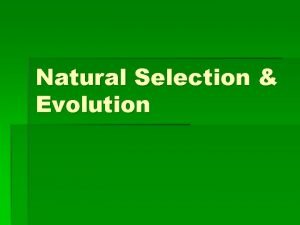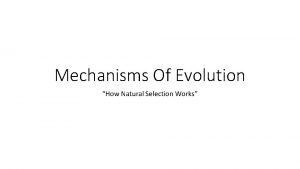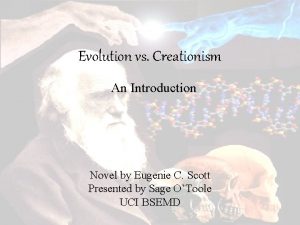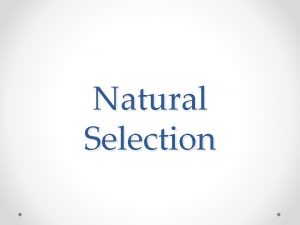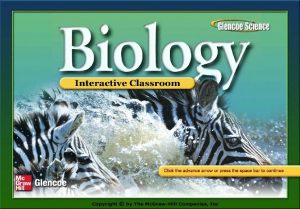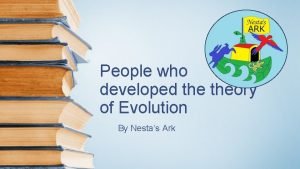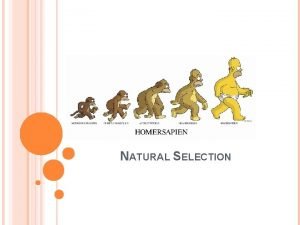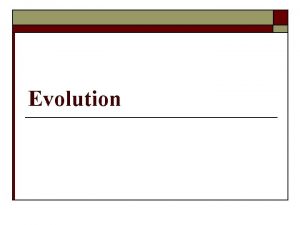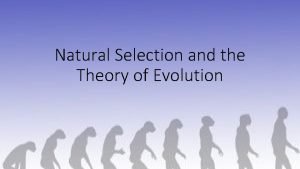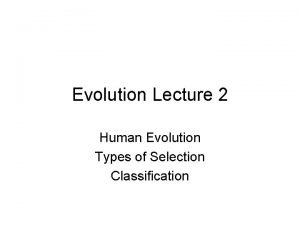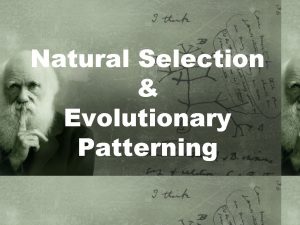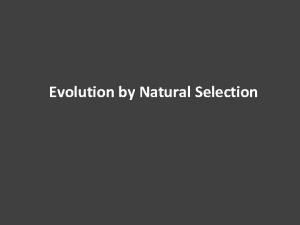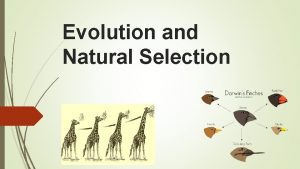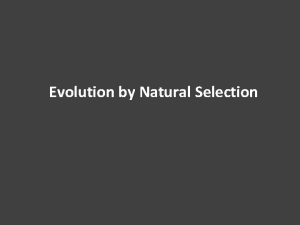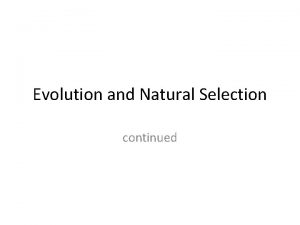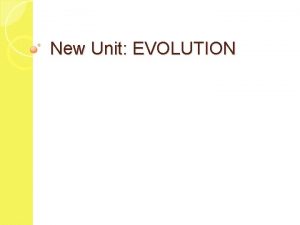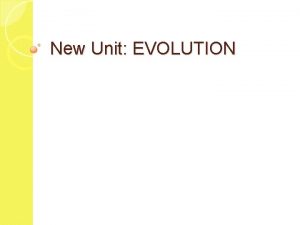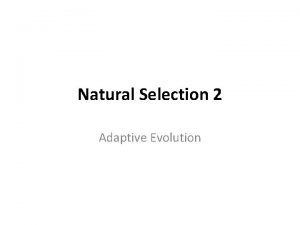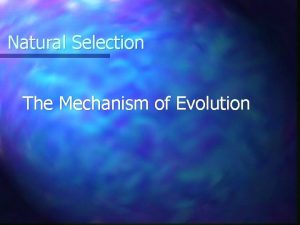EVOLUTION CONTINUED NATURAL SELECTION The theory of natural

















- Slides: 17

EVOLUTION, CONTINUED

NATURAL SELECTION � The theory of natural selection was developed by ____________ Charles Darwin ___ and first presented in his The Origin of book ____________, Species published in 1859.

THE THEORY OF NATURAL SELECTION 1. There is a struggle for existence among organisms.

THE THEORY OF NATURAL SELECTION 2. There is physical and behavioral variation in living organisms (even within the species level).

THE THEORY OF NATURAL SELECTION 3. Organisms with higher fitness (more helpful adaptations) are more likely to survive: “Survival of the Fittest. ”

NATURAL SELECTION 4. Over time, a natural selection will ensure that certain characteristics appear more and more often as they are passed through generations. Entire species can change over time in this way.

NATURAL SELECTION � Common descent/Descent with modification: Every living species has descended, with changes, from other species over time.

PUT THESE WORDS IN ORDER TO SUMMARIZE NATURAL SELECTION! Population s Survive and reproduce Individuals Mutate Gene s Evolv e

WHY ARE HUMANS SUCCESSFUL? 1. Walking upright—can use arms and see farther 3. Big brains for being awesome 2. Opposable thumbs for grasping

WHY CAN’T HUMANS EVOLVE TO COPE WITH OUR NEW ENVIRONMENTAL CONDITIONS? 1. 2. Genes for new traits have to already be present in a population’s gene pool through random mutation. Our generation times are too long to keep up with rapidly changing conditions—we aren’t fruit flies or bacteria! Human

MYTHS ABOUT EVOLUTION (THESE ARE UNTRUE STATEMENTS) 1. 2. 3. “Fitness” means strongest, fastest, or biggest. Organisms develop new traits in order to help them in their environment. Evolution is a constant progression towards some perfect ideal.

GEOLOGICAL PROCESSES AFFECT EVOLUTION 1. Locations of continents influence climate and habitats

GEOLOGICAL PROCESSES AFFECT EVOLUTION 2. Movement of continents allow for dispersal, speciation, extinction

3. Earthquakes can isolate populations, leading to speciation

4. Volcanoes can destroy habitat and cause extinction

5. Asteroid impacts can cause widespread extinction, climate

CLIMATE CHANGE AFFECTS EVOLUTION 6. Ice ages/warming periods cause migration, extinction, new niches
 3 types of natural selection
3 types of natural selection Mechanisms of evolution
Mechanisms of evolution Natural selection vs evolution
Natural selection vs evolution The slow gradual change in a species is called
The slow gradual change in a species is called Similarities
Similarities Natural selection vs artificial selection
Natural selection vs artificial selection Artificial selection vs natural selection
Artificial selection vs natural selection Disruptive selection.
Disruptive selection. Natural selection vs artificial selection
Natural selection vs artificial selection Chapter 15 section 1 darwins theory of natural selection
Chapter 15 section 1 darwins theory of natural selection Who formulated theory of evolution? *
Who formulated theory of evolution? * Theory of natural selection
Theory of natural selection Whats the theory of natural selection
Whats the theory of natural selection Theory of natural selection
Theory of natural selection Types of natural selection
Types of natural selection Balancing selection vs stabilizing selection
Balancing selection vs stabilizing selection K selection r selection
K selection r selection Logistic model of population growth
Logistic model of population growth
